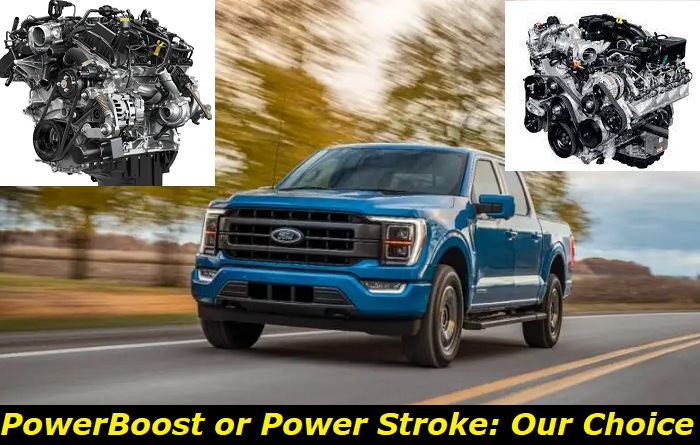It's easy to get torn between the PowerBoost and Power Stroke engines, because why not? Each power unit excels in its own right. One comes from Ford's long-running production engine with tested and proven performance and reliability while the other takes off from the automaker's long experience in engine history in its transformation to a hybrid build.
One specializes in diesel technology while the other focuses on a hybrid gasoline-electric system. More things differentiate the two and that's exactly what we will feature here.
Key features and my opinion about the PowerBoost engine
- Production years:2021-now
- Average lifespan of 3.5L V6 PowerBoost:200,000-240,000 miles
- Fuel supply type:direct injection
- Power range:430 hp
- Fuel efficiency:good
- Engine block material:aluminum
- Engine reliability score:medium
- The most common problems:oil leaks, turbocharger failure, overheating, spark plugs and ignition coils failure.

Ford PowerBoost
Not to be confused with the Ford EcoBoost, the PowerBoost is a relatively new player in the industry. It may not have the same bragging rights as the Power Stroke in terms of market longevity at this time, but it is no pushover. The product is a full-hybrid engine driven by both gasoline and electric to deliver plenty of power, range, and towing capabilities.
It was specially made for the Ford F-150 light-duty full-size pickup and was only introduced in the truck's 2021 model year as one of its power trim options.
The PowerBoost combines Ford's 3.5L turbocharged V6 EcoBoost engine technology with an electric motor technology to optimize the output of the current F-150. This makes the F-150 the first full-size pickup truck of its maker to offer a built-in generator.
The PowerBoost engine is designed to provide exceptional power and towing capability, while also delivering excellent fuel economy and range. It features two turbochargers, direct injection, and twin independent variable cam timing (Ti-VCT). The result is an engine that offers incredible power and performance, along with excellent fuel economy.
When properly equipped, the PowerBoost engine enables the F-150 to produce up to 430 hp and 570 lb-ft of torque. All that power is distributed via a ten-speed automatic transmission to a power split drivetrain.
For the uninitiated, a power split drivetrain is a type of vehicle transmission that uses two or more gears to split the power output between the front and rear wheels. It is commonly used in all-wheel-drive and four-wheel-drive vehicles, as well as in some hybrid and electric vehicles. The power split drivetrain allows for better traction and handling, as well as improved fuel economy.
Overall, the configuration takes the F-150 from 0 to 60 mph in just 5.4 seconds. Although not specified by Ford, tests have shown it can gain a top speed of 118 mph before its limited kicks in.
Furthermore, the setup lets the truck tow up to 14,000 pounds of equipment and haul a payload of up to 3,325 pounds. The PowerBoost engine is also estimated by EPA to get as much as 24 mpg on the highway and city, making it the most fuel-efficient full-size pickup truck on the market.
In its hybrid configuration, Ford claims that the vehicle is capable of reaching up to 700 miles on a single tank of gas but the EPA numbers only show 624 miles for it.
Based on projections, the 3.5L internal combustion engine of the PowerBoost can last over 200,000 miles with proper maintenance. The hybrid engine is not yet too far from its introduction year but there have already been complaints about it such as the following:
- Independent tests conducted by automotive experts found out that it actually had a lower actual fuel economy than the EPA estimates. Long drives have proven that its best numbers are only between 16.6 and 17.7 mpg combined, which is a far cry from the advertised 24 mpg.
- So far, the other common issues pointed out in a previous recall as well as customer complaints mainly focused on the driveshaft and electrical issues.
- At present, there is a consensus that the complexity of hybrid tech means more expensive maintenance costs associated with it.
Ford Power Stroke
The Power Stroke family of engines is old but gold. It is a line of diesel engines that was first introduced in the mid-1990s. The original engine was designed as a joint venture between Ford and Navistar International. The aim was to produce an engine that would be more powerful and efficient than the competition.
The first Power Stroke engine came out in the 1994 model year of the Ford F-Series pickup truck. It started with the 7.3L Power Stroke V8 diesel engine featuring cast-iron block and heads, as well as single, wastegate turbocharging. The result was an engine that could produce up to 275 hp and 525 lb-ft of torque, which was pretty impressive during its time.
The 7.3L Power Stroke engine continued to be used in the Ford F-Series until the 6.0L Power Stroke took over in 2003. On paper, the successor had a better power output at 325 hp and 560 lb-ft of torque, which was later revised to 570 lb-ft. However, it met major backlash all over its production run due to its plethora of problems that even resulted in class action lawsuits.
To make up for the bad reputation of the 6.0L Power Stroke, Ford replaced it with the 6.4L Power Stroke V8 diesel engine for the 2008 model year. The new engine featured common-rail fuel injection and compound VGT turbochargers. It produced 350 hp and 650 lb-ft of torque, trumping its predecessors. Some of the issues present in the 6.0L version also manifested during its time but it proved to be more capable of withstanding increased boost levels.
In 2011, the 6.7 Power Stroke took over the spot of the 6.4L to meet the stricter emission standards. In its last update, it proved its superb level of versatility as it took a whopping 475 hp and 1,050 lb-ft of torque improvement.
Due to its very high output potential, it easily became a darling to tuners. The superb power didn't translate to good fuel economy readings though as its best score was only 19.9 mpg based on reports. This version of the engine was used in the Ford F-Series until it was replaced by the 3.0L Power Stroke V6 diesel engine in 2018.
Ford announced the discontinuation of the Power Stroke after its 2021 model year. With that, the Power Stroke range culminated in the 3.0L turbocharged diesel V6 engine featuring common-rail fuel injection and twin turbochargers. The Power Stroke's final hurrah produces 250 hp and 440 lb-ft of torque.
Although not as powerful as the previous 6.7L Power Stroke engine, the 3.0L engine is significantly more fuel efficient. It is estimated to get as much as 30 mpg on the highway and 22 mpg in the city. When properly equipped, the 3.0L Power Stroke engine enables the Ford F-150 to tow up to 11,400 pounds of equipment and haul a payload of up to 2,020 pounds.
The Power Stroke range definitely had its ups and downs over the years. The most notorious was its 6.0L version, which was considered to be its weakest link.
In general, among the most commonly known issues of the Power Stroke in its various iterations were the following:
- Camshaft position sensor failure resulting in engine stalling and hard starts
- Fuel filter/water separator cracks causing fuel leaks
- Various electrical issues like shorting
- Turbocharger up-pipes failure
- Valves getting stuck on open
- Carbon build-up
- Fuel pump leaks
- Fuel injection malfunction
- Piston ring failures
- Rocker arm impacting
- Bearing, seal, and gasket premature wear
So, Which One is Better?
The answer to this question simply depends on your needs and preferences. If you need a full-size pickup truck that can tow a heavy load or haul a lot of cargo, then the PowerBoost engine is the way to go. On the other hand, if you have a bias towards the old-school driving pleasure derived from diesel, then the Power Stroke engine is the better option.
If you're looking way beyond those, one more angle to consider when making your choice is what the future of the PowerBoost and the Power Stroke holds. While the virtually new PowerBoost is currently seen as more expensive to maintain than the Power Stroke, the discontinuation of the Power Stroke may lead to its OEM parts becoming scarcer as the years go by.
In terms of the economics of scale, the trend may tilt in favor of the PowerBoost later on due to the foreseen growth of hybrids or electric vehicles on our roads in the coming years which will gradually reduce the cost of maintenance of hybrids and EVs.
One last thing to ponder is the fact that while diesel engines have long been the standard for commercial and heavy-duty vehicles, gas engines are now surpassing their popularity even in the pickup trucks segment. A good example of this is the evident shift of the F-150 to PowerBoost.
The dramatic shift in gasoline hybrid has to do with their continually improving fuel economy. Gasoline hybrids are now able to achieve numbers that were once thought impossible for such types of engines. While diesel engines have been known for their reliability and fuel economy in the past years, this is something that gasoline hybrids are now trying to emulate.
About the authors
The CarAraC research team is composed of seasoned auto mechanics and automotive industry professionals, including individuals with advanced degrees and certifications in their field. Our team members boast prestigious credentials, reflecting their extensive knowledge and skills. These qualifications include: IMI: Institute of the Motor Industry, ASE-Certified Master Automobile Technicians; Coventry University, Graduate of MA in Automotive Journalism; Politecnico di Torino, Italy, MS Automotive Engineering; Ss. Cyril and Methodius University in Skopje, Mechanical University in Skopje; TOC Automotive College; DHA Suffa University, Department of Mechanical Engineering






Add comment